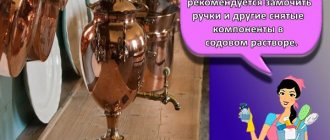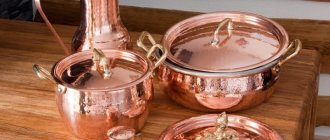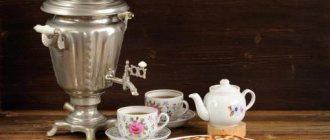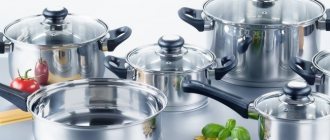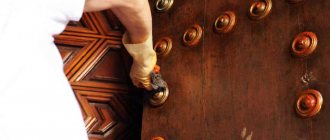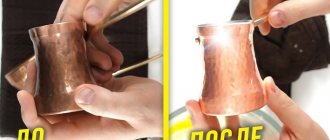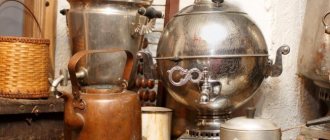A samovar is a water heater that belongs to ancient traditions that our ancestors maintained. It is also found in the homes of modern people. The advantage of the device is its ability to maintain water temperature for a long time, which is absent in other conventional kettles. Due to the widespread use, the question of how to clean a samovar is relevant for many people. It is relatively easy to clean it from plaque and other contaminants, and this can be done with improvised means.
Cleaning the brass surface
A brass samovar is cleaned with ammonia or oxalic acid.
Ammonia
Using ammonia for cleaning a regular and electric samovar:
- lightly moisten the cloth with ammonia;
- wipe the surface;
- rinse.
Oxalic acid
When working with oxalic acid, use gloves:
- stir oxalic acid in water according to the instructions (usually 100 g/3 l);
- moisten the surface of the device with liquid for 5 minutes;
- wash away;
- clean with soda;
- rinse;
- Rub the samovar until shiny with a soft cloth.
Cleaning small parts
Small parts of the samovar can be cleaned by boiling them for 30 minutes in a solution of water and soda ash (½ l:20 g).
Folk remedies
You can use folk remedies to clean both internal and external surfaces. The most popular are:
- vinegar;
- lemon;
- toothpaste;
- coca-cola;
- dentifrice.
You can clean the outer walls until they shine using toothpaste or tooth powder. The principles of action of these substances are no different. When using toothpaste, it is applied to the outer surface of the dirty area and rubbed in. The powder is also used, but before this the outer surface is moistened with warm water. Residues of teeth cleaning products must be thoroughly rinsed off the outer surface, then polish the outer walls with lint-free wipes or pieces of cloth.
Toothpaste will help you clean the samovar until it shines.
A simple drink of Coca-Cola can clean the inside of a samovar. This is a very aggressive product, used only in cases of severe contamination. It helps remove scale from the heating element. This is done as follows:
- Coca-Cola is poured inside the samovar in an amount to completely cover the heating element (plus 2-3 cm).
- Then the samovar is heated for 15 minutes.
- After this, you should cool the Coca-Cola directly in the samovar. When it cools, it is poured out and the internal surfaces are cleaned.
It has been observed that residual taste may be present in the first two servings of water. Therefore, it is recommended to boil the water dry immediately after cleaning. If necessary, this can be done twice.
When using lemon, wipe the inner surfaces of the walls. This way they are cleaned of a thin layer of scale. Cleansing is carried out as follows:
- Lemon is cut into thin slices.
- The inner walls are wiped with slices.
- To purify, one portion of water is boiled idle.
If desired, you can use freshly squeezed lemon juice. A cotton wool is moistened in it and the walls are treated.
Lemon will help cope with many impurities
You can also clean the samovar using vinegar. It is advisable to choose 6 percent. In its absence, you can double the cleaning time with three percent, but it is better not to use nine percent - it is too concentrated. A piece of cotton wool is soaked in the essence and the surface is wiped with it. Wipe the outer and inner walls until shiny. The more soiled, the more cotton swabs you will have to change.
Cleaning stainless steel surfaces
Stainless steel cookware loses its luster over time, becomes dull, and becomes stained. There are several options for cleaning a stainless steel samovar. The most commonly used are Goya paste and vinegar, available in every home.
Vinegar
Using vinegar is very simple:
- moisten a cotton pad or swab with 9% vinegar;
- wipe the surface.
Paste GOI
In addition to stainless steel, Goya paste can be used to clean copper samovars and brass products. It can not only clean, but also add shine:
- put a little paste on a soft cloth;
- clean the product;
- Remove residues with alcohol.
Important! Apply the paste gradually - after cleaning one area, apply it to another area.
Household products
Household products are also used to clean samovars. The most popular are:
- liquid laundry soap;
- dishwashing detergents;
- soda solution;
- solid laundry soap;
- dishwashing powders.
Some types of samovars cannot be cleaned with abrasives. These include dishwashing powders and baking soda. What materials cannot be cleaned with abrasive particles are described in the sections above.
You can use laundry soap to clean external dirt such as grease stains or food stains. In this case, liquid laundry soap is applied in a thin layer, and a sponge is soaped with solid soap, which is used to treat the surface. Contaminants should be cleaned using hot water or even boiling water - this way they will come off better. Remaining soap should be rinsed off thoroughly.
It is not recommended to clean internal surfaces with laundry soap. They will not be able to remove scale on the walls or heating element. In addition, the smell of soap is difficult to dissipate.
Dishwashing detergents are used in the same way as liquid laundry soap. They are considered the best for cleaning stainless steel samovars. The stainless steel device can be cleaned with dishwashing detergent both outside and inside. It is advisable to choose products that are odorless. Otherwise, it is necessary to leave the samovar open, and also boil 2-3 portions of water after cleaning. Dishwashing detergent will not be able to remove deep layers of scale. It helps remove thin greasy deposits or film on the inner walls.
Soda solution can be used in combination with other ingredients or alone. For independent use, a small amount of baking soda is mixed with a few drops of water. For one teaspoon of baking soda, one teaspoon of water is enough. This mixture is applied to the outer walls of the samovar, the material of which allows it to be cleaned using abrasive particles. Then, using a kitchen sponge or scrubber, baking soda is used to remove dirt from the outer walls. It is not recommended to clean the inner walls with soda, and it is prohibited to use soda on heating elements.
Cleaning the samovar both inside and outside is possible using improvised means. In this case, the material used to make the device and the location of the contaminated parts are important. With timely cleaning, you can extend the service life of even vintage devices for a long time!
An effective samovar cleaner
Internal cleaning
After cleaning the outer surface, you should remove the scale in the samovar, which can significantly distort the taste of the prepared drinks. You can clean the inside of the samovar using the following means.
Sweet sodas
The first option on how to clean the inside of a samovar is to use sweet sodas (for example, Sprite, Coca-Cola, etc.):
- pour soda into the samovar;
- leave overnight;
- pour out;
- clean off dirt with a brush;
- rinse.
Potato peelings
Using potato peelings is an old way to remove scale:
- rinse cleaning;
- pour them into the samovar;
- fill with water;
- boil for 30 minutes;
- leave to act for 2–3 hours;
- throw away the cleaning;
- rinse;
- Clean any remaining dirt with baking soda;
- rinse.
Cleaning the inside, done with scrubbing and baking soda, should be followed by boiling the water again to complete the process.
How to clean a samovar until it shines: general recommendations
Before washing off stains, determine the material of the product, since the processing method and the choice of cleaning agent depend on it. Typically, copper, brass or stainless steel is used for manufacturing . Aluminum and nickel-plated products are quite rare.
Be sure to find out whether the item has historical value (especially for coal-fired samovars). To do this, carefully examine it from all sides. If you find a mark or ancient inscriptions, contact a specialist and find out the cost of such a relic. If the product is not a rarity, clean it and use it for making tea or conducting themed photo shoots.
When choosing a cleaning method and method, consider the age of the product and the material from which it is made
General cleaning recommendations:
- Disassemble the product by unscrewing all handles, stands, valves and decorative elements. This will make the cleaning process easier and help achieve better results.
- Use gentle cleaning products. Do not use compounds with abrasive particles, even if you need to clean an old samovar. Such products leave scratches, which spoils the aesthetic appearance.
- For cleaning, use only soft sponges or cloth. This will not only help avoid damage, but will also make the product shiny.
- Before using any product, test it on an inconspicuous area and observe the reaction. If the treated area has changed color, use a different solution.
The product should be cleaned with protective gloves and a respirator, especially when using aggressive agents - vinegar, ammonia, oxalic acid. This will protect the skin and respiratory tract from burns.
How to tidy up a litunite device
Brass should be stored in a place where there is no dampness. This way plaque will form less often. But, if it does appear, it should be removed carefully; it is better not to use products based on aggressive chemicals.
You can get rid of scale with vinegar. To do this, dilute 1 bottle of acid with water so that the liquid fills the entire volume. Heat to 60 degrees and leave for 60 minutes. After the procedure, the inner surface must be washed.
Ammonia and oxalic acid clean brass perfectly. To do this, take 1 tbsp. ammonia or acid and add 1 liter of water. You need to clean the samovar with the solution, and a few minutes after that, wipe it with a sponge and soda to neutralize the effect of the acid. Then you should rinse off the product, be sure to wipe the surface dry, after which you can polish.
How to prevent scale from appearing
If a white coating constantly appears in your samovar, it means the water is too hard. It contains a lot of mineral salts, and believe me, this is not “Essentuki” at all. If you drink such water constantly, your teeth will deteriorate and problems with your stomach, liver and kidneys will begin. To prevent this from happening:
- Buy clean bottled water.
- Install a quality water filter.
Inexpensive models remove only mechanical contaminants: fine suspension, rust, tiny particles of debris. But you need a softening filter or reverse osmosis filter. Such models are more expensive and more difficult to install.
Polishing a samovar with your own hands
To make the samovar shine, complete the last step - wipe the surface with a soft cloth with lint, which will do the job perfectly.
Egg whites and sodium hydrochloride will help restore the former beauty of a metal device.
The samovar is a true rarity of our time, so take care of it like the apple of your eye. Treat it carefully, with care, with trepidation, so that it will serve you for quite a decent period of time!
Delicious tea from a samovar that exudes a pleasant aroma - let it create an atmosphere of comfort and harmony in your home!
Tips for use and care
- Draining the remaining cooled water after boiling will prevent scale formation.
- Brass samovars do not tolerate moisture. To preserve their appearance, they need to be stored in dry places.
- To prevent plaque from forming on the copper device, it is worth periodically wiping the surface with lemon and a soft brush.
- If possible, it is advisable to take the samovar to a professional polisher once every 5-15 years.
- Regularly wipe the product from dust. Sometimes take it apart and wash all parts.
- A hot appliance must not be left without water.
If you follow these simple rules, the samovar will delight you with delicious aromatic tea for decades.
Nickel-plated samovar: cleaning methods
Effective products for cleaning tarnished nickel surfaces:
- Wipe with a cloth soaked in table vinegar. You can even soak an old item in a vinegar solution for a couple of hours (1 part vinegar + 4 parts water). After treatment, rinse off the product with clean water.
- You can also clean nickel with the following mixture: 30 g of ammonia, 15 g of tooth powder, 50 ml of water.
- There are special pastes for cleaning nickel-plated and chrome-plated products. It is enough to apply this on a soft cloth and polish the samovar.
Effective methods for removing internal scale
Having completed the external cleaning of the samovar, you must immediately begin removing scale from its internal walls. Otherwise, a drink made from such water will not please you with its taste.
To obtain optimal results, you can use one of the following methods:
- We take potato peelings, rinse them several times under the tap and put them in the samovar. Pour boiling water over them and leave until it cools completely. We repeat this three times, constantly changing the cleaning. Then we empty the container, rinse it and rub the inside with baking soda powder. It is best to use a soft brush, then you will be able to remove all traces of scale. Rinse the samovar again, pour water into it and boil it. We drain the liquid, only after this the device is allowed to be used for its intended purpose.
- Sweet carbonated water is no less effective at removing limescale. It needs to be poured into a samovar, boiled for half an hour and drained. After this treatment, the remaining scale can be easily removed with a brush or hard sponge.
In addition, acetic or citric acid and soda are used to treat the internal surfaces of the samovar. These options are no less effective, but can leave behind a specific odor that will disappear only after a few days.
Causes of contamination and indications for cleaning
Even the most careful housewife faces a problem when the samovar becomes dull, plaque and water stains appear. And this is not due to the lack of proper care, but to the peculiarities of operation, namely:
- The appearance of soot in the upper part is typical for improper use of the samovar, when the lid is covered during the active process of fuel combustion.
- No removal of soot and deposits after drinking tea. Old soot accumulates and becomes more difficult to deal with.
- Stains on the surface occur when water splashes on the surface of the samovar.
- Internal scale is associated with the characteristics of the water.
If the samovar is located in close proximity to the frying surface, there is always a risk that drops of fat will become habitual companions of an old electric kettle.
Cleaning should be done if:
- The samovar has lost its shine, there is no display on its surface.
- There are stains and stains, the surface has become duller.
- White flakes are present in boiled water, which indicates the presence of scale inside the samovar.
- The top of the samovar becomes covered with a black coating that cannot be wiped off with a sponge.
A samovar with stains and stains
Cleaning a samovar is not difficult, but you need to know some features so as not to damage the device.
Preventive measures against scale formation
Scale is formed as a result of high water hardness, therefore, to avoid its formation in the samovar, special water hardness softeners can be installed on the water pipes. It is also necessary to completely drain the water from the samovar after using it, and regular cleaning in order to prevent the deposition of salts on the walls and the formation of scale.
A samovar is not just a device for making tea. This is home warmth and comfort, intimate conversations and a pleasant rest. Regularly descale your samovar, and it will last for many, many years, giving your whole family the opportunity to taste wonderful aromatic tea!
Features of cleaning samovars made of various materials
Before cleaning the product, you need to carefully inspect it for the presence of a mark or any initials or inscriptions. If you find them, it is better to contact an antiques specialist. An antique branded samovar of historical value will certainly be of interest to collectors and will cost a lot of money. If improperly maintained, the coating can be damaged. Therefore, it is very important to know what metal the samovar is made of and select a method based on this. However, there are cleaning recommendations that apply to all types:
- Disassemble the product and wash the removable elements separately.
- Use only soft sponges or towels, different ones for internal and external surfaces.
- Before cleaning the entire product, test the product on an inconspicuous area. If the material has darkened or changed in some way, it is better to look for other methods.
Advice! It is important to protect your hands from harsh cleaners such as vinegar or ammonia. Thick rubber gloves will help you avoid them.
Brass
This is the name of an alloy of zinc and copper, products from which are quite difficult to care for. It is prohibited to use household chemicals to clean brass! When reacting with cleaning agents, such a coating will begin to oxidize. To clean a brass samovar, only traditional methods can be used.
Ammonia
Used for minor stains, when you need to “refresh” the surface a little.
- Prepare a solution of 1 liter of warm water and 1 tsp. ammonia.
- Wipe the samovar with a cloth soaked in the solution.
- Wipe dry, polish.
Oxalic acid
It perfectly helps to cope with the darkening of metal. To clean you need:
- Prepare a solution and 1 tbsp. l. acid and 1 liter of water.
- Apply the resulting mixture to the device.
- Wait 5 minutes, rinse well in warm water.
- Wipe with a soft sponge and soda, rinse.
- Polish with a soft cloth.
Advice! Instead of acid, you can use ammonia.
Soda Ash
Suitable for lightening small removable parts:
- Remove small parts and soak in 0.5 liters of water.
- Add 20 g of 4% soda.
- Leave to boil for half an hour.
- Clean with a cloth and rinse.
Stainless steel
Stainless steel is very popular now. It is easy to care for, it can be cleaned, and is not very sensitive to detergents. The only thing that steel cannot tolerate are powders, brushes, and other scratching substances. Stainless steel can be cleaned using the following methods.
Soapy water
- Soak the samovar in soapy water for 2-3 hours.
- Rinse with clean water and dry.
Vinegar
If soap doesn't help, vinegar will come to the rescue:
- Soak a cloth in 9% acetic acid.
- Clean the surface of the device.
- Polish the samovar with a soft cloth.
Paste GOI
The paste is used for grinding and polishing a wide variety of materials: from steel to plastic.
Mode of application:
- Apply GOI to a soft flannel cloth.
- Polish the surface of the samovar.
- Go over the product again with a dry cloth.
Raw potatoes
- Cut raw potatoes into 2 parts.
- Rub the walls of the device until it is clean.
- Polish with a dry cloth until shiny.
Copper
When interacting with air, the copper surface oxidizes and acquires a greenish coating. The following methods will help you clean it from unsightly stains.
Detergent
You can clean a copper samovar with a sponge soaked in dishwashing detergent, and then dry it thoroughly and polish it.
Lemon and salt
- Cut the lemon into halves and sprinkle with salt.
- Wipe the samovar with a piece, but do not scratch it.
- Rinse the device and polish it to a shine.
Salt, flour and vinegar
- Mix a glass of flour, 1 tbsp. l salt and 100 ml vinegar.
- Apply the mixture to the device and rub well with a cloth.
- Rinse and dry.
Tomato paste
- Apply the paste in a thick layer to the stains.
- Rinse off with warm water.
Chalk and ammonia
- Mix crushed chalk with ammonia and water in a ratio of 2:5:10.
- Rub into the product, wait 10 minutes.
- Clean with a soft brush.
- Rinse off the solution.
Aluminum
You can clean an aluminum samovar with a large number of products. You just need to remember that aluminum is a soft metal, so any abrasives are prohibited.
Vinegar
You can walk over the material with a cloth previously moistened with vinegar or a vinegar solution (in a 1:1 ratio), and then rinse and wipe dry.
Detergent
The easiest way to wash the device is like regular dishes - with a sponge and detergent.
Alcohol
You need to moisten a rag with alcohol and rub the stains until they disappear.
Ash
As strange as it may sound, ashes help clean aluminum appliances. You need to make a paste from wood ash and water, wipe the samovar with it, and rinse with clean water.
Nickel and chromium
A nickel-plated samovar requires careful cleaning, as the coating is easily damaged. Therefore, you cannot use dry powders, abrasives, or acids. Here are the most convenient ways to clean it:
- Dishwashing liquid
- Soda
- A solution of chalk and salt (1:1) in water
- A mixture of 2 parts ammonia and 1 part tooth powder, diluted in 3 parts water.
- Occasionally use salt mixed with apple cider vinegar to form a paste.
How samovars were cleaned in ancient times in Rus'
In the old days, the samovar played an important role in every home, so it was regularly wiped until it shined. Sorrel leaves were most often used. They were taken in a bunch and squeezed, then the samovar was wiped. In winter, fresh sorrel was impossible to find, so frozen cranberries were used. They were defrosted over the fire and the walls of the samovar were rubbed in a circular motion. A little later, salt, clay and chalk came into play.
The samovar was once the main thing in the kitchen of every family. Today it is used more often by lovers of antiques, although its tea-brewing qualities are in no way inferior to modern devices. If you suddenly decide to purchase or take a samovar out of the pantry, then do not worry about its appearance, because there are a large number of methods for cleaning it and polishing it to a perfect shine.
Tinning a samovar at home
If you are restoring an antique samovar to boil water in it, be sure to look inside. Do you see a dark film inside that covers the surface of the metal? These are harmful oxides. They need to be removed.
To do this, the samovar is tinned - that is, covered with a protective film of tin. It's easy to do:
- Polish the inner bowl with fine sandpaper and rinse thoroughly.
- Rub the inside of the samovar with soldering acid or ammonia.
- Place the bowl on the fire and melt some soldering tin there. Choose pure metal without impurities.
- Shake the container, distributing the liquid metal along the walls. You can “smear” it with flax fiber, but be careful - the temperature of straightened tin exceeds 230 °C.
- Repeat the procedure until the inner bowl of the samovar is covered with a layer of metal of the same thickness.
In the same way, you can tin any internal surface of the samovar that comes into contact with water.
General recommendations
You can avoid the appearance of burning in rooms with a fireplace or stove, provided that you follow the rules for using heating facilities
It is important to clean chimneys on time. To do this, burn off the soot with aspen firewood, potato peelings or salt.
You can also purchase special products for cleaning pipes from soot.
Ammonia is used to remove soot from surfaces. It is added to water during wet cleaning. Ammonia, together with baking soda, added to water will help get rid of the acrid smell of smoke and burning. At the end of washing the apartment, you should use a sealant. It is applied to the walls, then primed. They do not forget that they begin freeing the house from soot and soot with dry cleaning, only then doing wet cleaning.
Share link:
